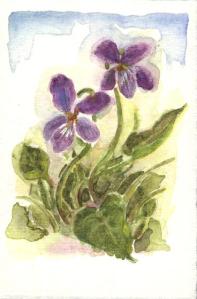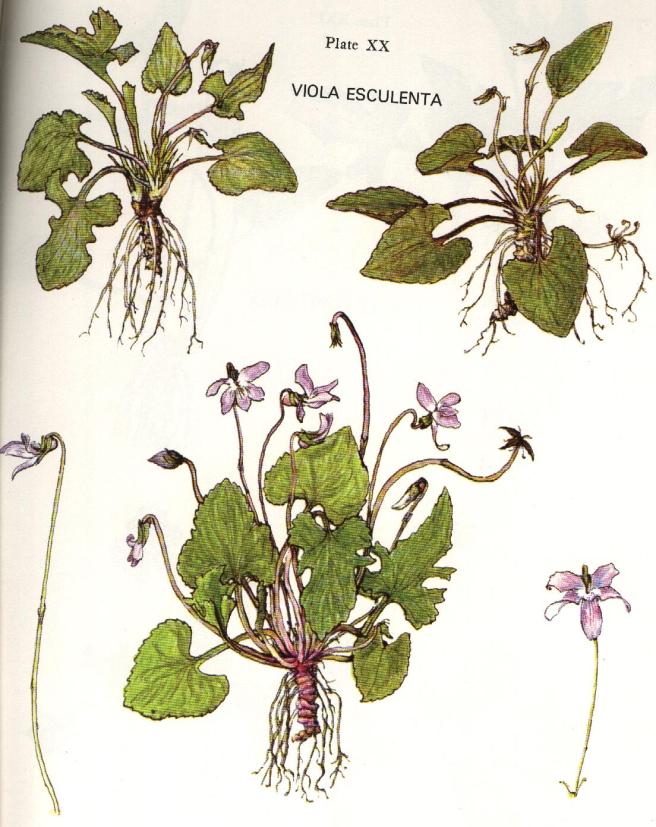
 iolets? In August? Please let me explain. Our weather, even for the Midwest, has been difficult this summer, with monsoonlike rains one day, and jungle-like humidity the next. So plants are having a fine old time, skyrocketing upwards, falling over, becoming huge, and otherwise getting out of control. I shake my fist at them: “Just you wait! I’ve got the clippers!” Is it my imagination, or do they laugh? At any rate, on days like this I retreat to the garden of my imagination, where bluebirds sing, and my garden, tended by Snow White and the Seven Dwarfs, is always beautiful. And lately I’ve been dreaming about violets, and have been reading about them, because, believe me, they aren’t going to actually grow in my garden.
iolets? In August? Please let me explain. Our weather, even for the Midwest, has been difficult this summer, with monsoonlike rains one day, and jungle-like humidity the next. So plants are having a fine old time, skyrocketing upwards, falling over, becoming huge, and otherwise getting out of control. I shake my fist at them: “Just you wait! I’ve got the clippers!” Is it my imagination, or do they laugh? At any rate, on days like this I retreat to the garden of my imagination, where bluebirds sing, and my garden, tended by Snow White and the Seven Dwarfs, is always beautiful. And lately I’ve been dreaming about violets, and have been reading about them, because, believe me, they aren’t going to actually grow in my garden.
 In “Violets: The History & Cultivation of Scented Violets,” by Roy E. Coombs, we learn that violets were among the earliest flowering plants to be grown commercially, and were sold in the markets of Athens as far back as 400 BC. Victorians were mad about violets. Whole nurseries were devoted to their cultivation and there were hundreds of varieties, some highly scented.
In “Violets: The History & Cultivation of Scented Violets,” by Roy E. Coombs, we learn that violets were among the earliest flowering plants to be grown commercially, and were sold in the markets of Athens as far back as 400 BC. Victorians were mad about violets. Whole nurseries were devoted to their cultivation and there were hundreds of varieties, some highly scented.
So that we can pleasantly meditate on violets and turn our thoughts from humidity and weeds, I have come up with a project for making violet pins with clay that is molded, baked, painted, and varnished. You didn’t have anything else to do today, did you? For pictures of violets to consult, look in a wildflower identification guide. Or, unearth the above-mentioned book by Mr. Coombs. It’s astonishing just how many varieties there are, but as a Midwesterner, collecting and growing violets is a non-starter. Only wild violets, and the demonical violet known as “Freckles” seem happy here. (Readers questioning that a violet can be demonical haven’t met Freckles.)
Materials: 2 ounces of oven-bake clay, such as Sculpey
a metal skewer
acrylic craft paints in white, cream, pale blue, lilac and violet
acrylic satin interior varnish
a small, round paint brush
pin backs and jewelry glue
I had written rather elaborate instructions for making these, but I think the following illustrations are easier to follow.  You are basically rolling little balls of clay, pinching them, flattening them, and then pushing together to make a flower. How pointed or round, how drooping or sprightly you make the petals depends on the violet you are trying to portray. Place the flower on a baking sheet and lightly press it down with your hand. Following the package instructions, bake the violets. In my experience, it takes about 13 minutes. Allow to cool.
You are basically rolling little balls of clay, pinching them, flattening them, and then pushing together to make a flower. How pointed or round, how drooping or sprightly you make the petals depends on the violet you are trying to portray. Place the flower on a baking sheet and lightly press it down with your hand. Following the package instructions, bake the violets. In my experience, it takes about 13 minutes. Allow to cool.
Paint the violet of your dreams, or from a picture of a violet, or, better yet, look at an actual violet. I like to paint a base coat color, and then let it dry. Then I mix another purple or blue shade with a bit of the satin interior varnish, and paint this on as a glaze. You can also shade the violet with deeper colors, or highlight with lighter colors. You might also want to paint very fine lines coming from the center of the violet. Paint the very center of the violet yellow, chartreuse, gold, or pale green. Paint the other side of the violet white. Allow to dry, and varnish with two coats of satin interior varnish.
Violet varieties from “Violets” by Doretta Klaber
Allow the violet to completely dry, and then glue it to a pin back with so-called “model/hobby cement,” or “jewelry glue.” White craft glue isn’t strong enough for this purpose.
I store these pins in little cardboard jewelry boxes with cotton batting to protect them from getting scratched.
A violet by a mossy stone
Half-hidden from the eye!
Fair as a star, when only one
Is shining in the sky.
Wordsworth.
For more info about violets, visit the website of the American Violet Society at americanvioletsociety.org.


Fran, these are beautiful!
Glad you like!